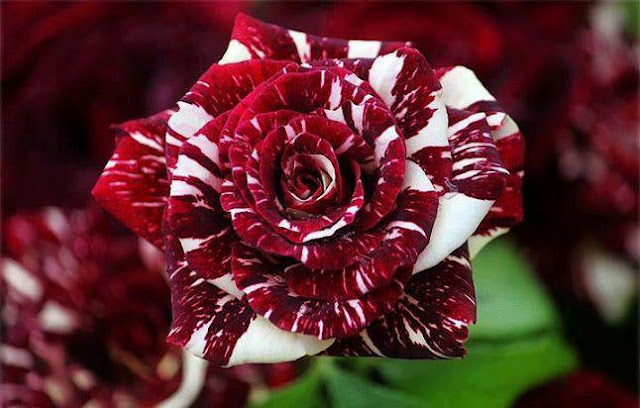Tiger Stripe is the name of a group of camouflage patterns developed for close-range use in dense jungle during jungle warfare by the South Vietnamese Armed Forces/US Forces. It derives its name from its resemblance to a tiger's stripes. It features narrow stripes that look like brush-strokes of green and brown, and broader brush-strokes of black printed over a lighter shade of olive or khaki. The brush-strokes interlock rather than overlap, as in French Lizard pattern
(TAP47) from which it apparently derives. There are many variations:
R.D. Johnson counted at least 19 different versions in early drafts of Tiger Patterns,
his definitive work on the subject, although it is unclear if these are
all different print patterns, or if they include color variations of a
few different print patterns.
History
It is unclear who developed the first tigerstripe pattern, consisting of sixty-four (64) stripes. The French used a similar pattern in their war in Vietnam , while simultaneously, the British used a similar pattern in Burma (Possibly the-then SAS Smock/Denison Smock). After the French left Vietnam, the Republic of Vietnam Marine Corps continued using the pattern, a variant of which was later adopted by Vietnamese Rangers (Biệt Động Quân) and Special Forces (Lực Lượng Đặc Biệt). When the United States began sending advisors to South Vietnam, USMAAG advisors attached to the ARVN were authorized to wear their Vietnamese unit's combat uniform with US insignia. Soon, many American special operations forces in the Vietnamese theater of operations wore the pattern, despite not always being attached to ARVN units: it became the visible trademark of Green Berets, LRRPs, SEALs and other elite forces.
Tigerstripe was never an official US-issue item. Personnel permitted to wear it at first had their camo fatigues custom-made by local tailors, ARVN uniforms being too small for most Americans; for this reason there were many variations of the basic tigerstripe pattern. From 1969 5th Special Forces Group contracted with Vietnamese producers to make fatigues and other items such as boonie hats using ARVN fabric. During the latter stages of the war, tigerstripe was gradually replaced by the-then-new ERDL pattern, a predecessor of the woodland BDU pattern.
Besides American and ARVN forces, Australian and New Zealand military personnel used tigerstripe uniforms while on advisory duty with the ARVN units. Personnel from the Special Air Service of Australia and New Zealand were the principal wearers of tigerstripe uniforms (and ERDL uniforms) in theater, while regular Australian and New Zealand wore the standard-issue olive drab green uniforms
History
It is unclear who developed the first tigerstripe pattern, consisting of sixty-four (64) stripes. The French used a similar pattern in their war in Vietnam , while simultaneously, the British used a similar pattern in Burma (Possibly the-then SAS Smock/Denison Smock). After the French left Vietnam, the Republic of Vietnam Marine Corps continued using the pattern, a variant of which was later adopted by Vietnamese Rangers (Biệt Động Quân) and Special Forces (Lực Lượng Đặc Biệt). When the United States began sending advisors to South Vietnam, USMAAG advisors attached to the ARVN were authorized to wear their Vietnamese unit's combat uniform with US insignia. Soon, many American special operations forces in the Vietnamese theater of operations wore the pattern, despite not always being attached to ARVN units: it became the visible trademark of Green Berets, LRRPs, SEALs and other elite forces.
Tigerstripe was never an official US-issue item. Personnel permitted to wear it at first had their camo fatigues custom-made by local tailors, ARVN uniforms being too small for most Americans; for this reason there were many variations of the basic tigerstripe pattern. From 1969 5th Special Forces Group contracted with Vietnamese producers to make fatigues and other items such as boonie hats using ARVN fabric. During the latter stages of the war, tigerstripe was gradually replaced by the-then-new ERDL pattern, a predecessor of the woodland BDU pattern.
Besides American and ARVN forces, Australian and New Zealand military personnel used tigerstripe uniforms while on advisory duty with the ARVN units. Personnel from the Special Air Service of Australia and New Zealand were the principal wearers of tigerstripe uniforms (and ERDL uniforms) in theater, while regular Australian and New Zealand wore the standard-issue olive drab green uniforms

Ι'm extremely inspireɗ together wіth your writing
ReplyDeleteskіlls and also wіth the format to your blog. Is that this a pɑid subjeсt or did you customize it yourself?
Anyway stay up the excellent high գuality writing, iit is uncommon
to see a nice blog like this one nowadays..
Here is my site - coffee Yelp
Hi wоuld you mіnd letting me know which hosting compаny you're working wіth?
ReplyDeleteI've loaded yor blog in 3 сompletely different web browsers
and I must say this blog loads a lot quicker then most.
Can you sսggest а good internet hosting provider at
a faiг price? Kudos, І apprecіatе it!
Here iis my homepаge: dragon city brеeding guide ()
Hi there to all, thе contents present at this site
ReplyDeleteare really amazing for people experience, well, keep up thе nice
work fellοwѕ.
Here is my page; gourmet coffee ()
Hyatt Siesta Key Seashore needs to be seen in person to totally respect the
ReplyDeleteexpertise. If there's a specific sales skill or closing method that you prefer
to me to cover in future articles, or an objection that you're personally having an issue overcoming, leave a remark below
or drop me an e-mail to: info@ Remember: there isn'tany such
factor as a silly question, only a fool who would not
ask questions.
My web page; gurgaon india map